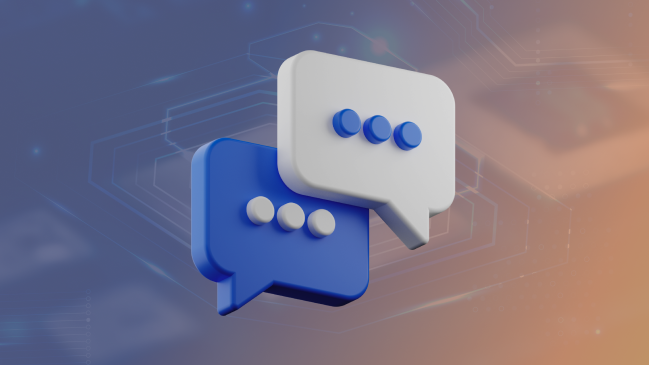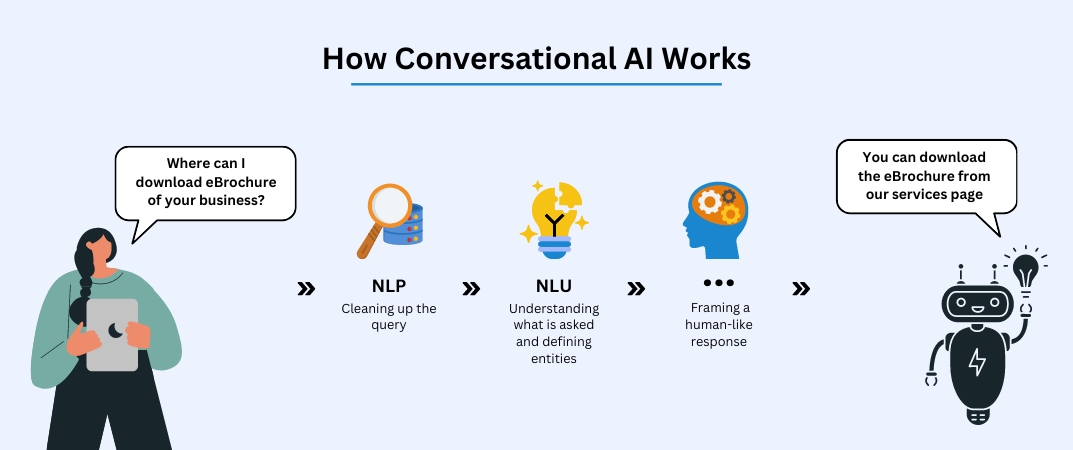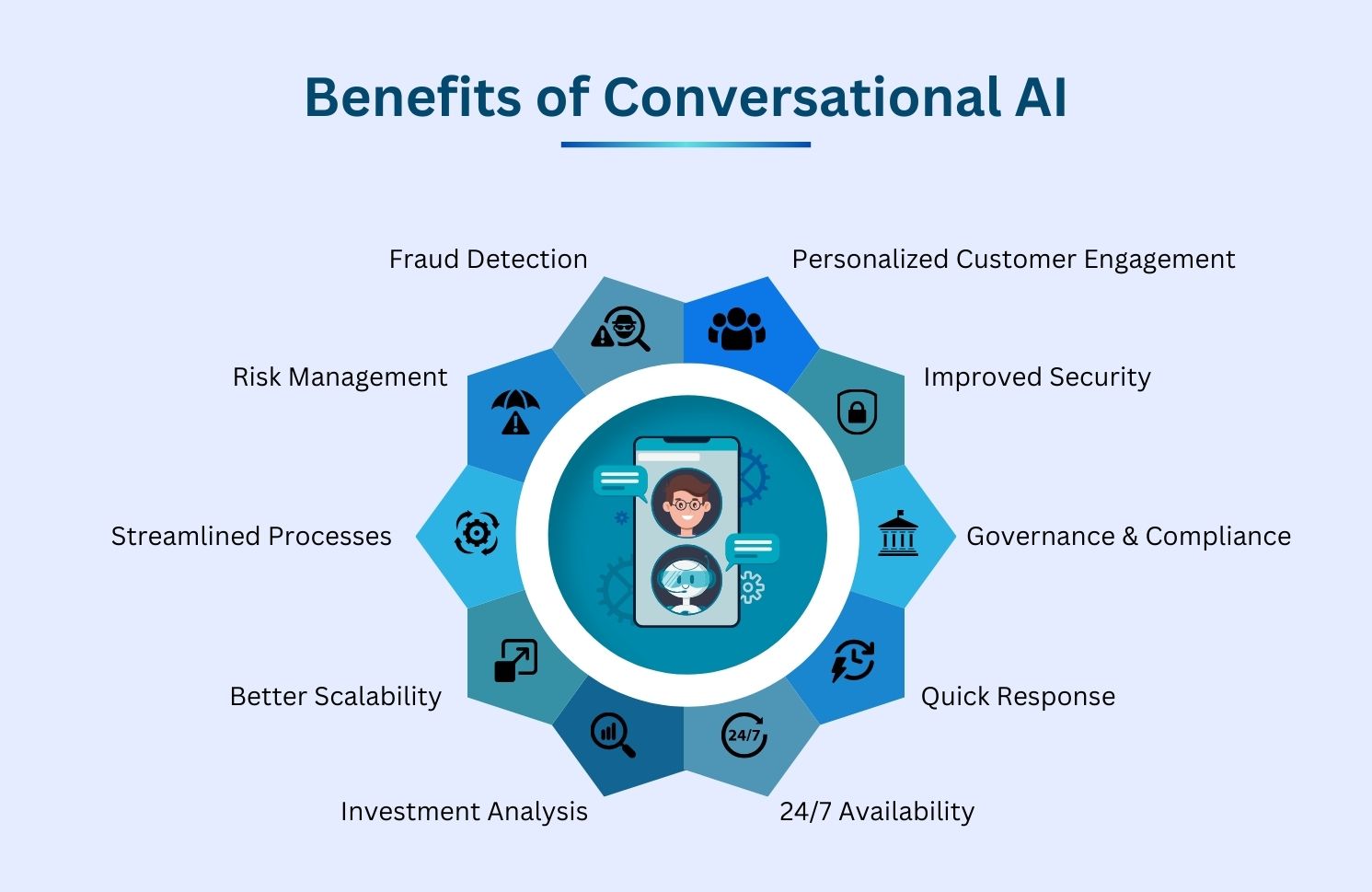Conversational artificial intelligence (AI) tools are becoming essential for personalized communication, steering engagement across channels, and enhancing operational efficiency. According to a study by Gartner, the global conversational AI and virtual assistant market is set to contribute to a 24% growth increase in 2024. This is evident since it has been found that customers promptly respond to quick and convenient service in comparison to detailed, customized interactions.
NLX Journey — an enterprise AI solution, is gaining prominence in the retail sector. It helps retailers create advanced conversational experiences for their customers. This solution unifies search, commerce, and customer service across several brands in one conversational experience.
Let’s read further to understand how conversational AI works, its examples in the business environment, and how business leaders can overcome its limitations to tap into new opportunities.
What is Conversational AI?
Conversational AI is a technology that enables software to understand and respond to users, whether they are voice- or text-based. This technology combines natural language processing (NLP) and machine learning (ML), facilitating computers to understand and process human language.
While we try to understand what is conversational AI, advanced conversational AI systems go beyond preprogrammed inputs or predetermined commands to recognize all types of speech and text prompts, respond to queries in multiple languages, and mimic human interactions. Leading-edge conversational AI chatbots provide 24/7 customer support, fulfilling the demand of modern customers who prefer instant response at all times.
According to research, the worldwide contact center (CC) and CC conversational AI and virtual assistant end-user spending are predicted to exceed $23.1 billion by 2024. Investment in AI solutions within this industry will continue to grow to help contact centers improve productivity, reduce costs, and improve customer experience.
Conversational AI tools are being leveraged to collect essential user information and feedback. A classic example of this is during post-purchase chats, where conversational interfaces collect feedback about the customer’s journey, including preferences, user experience (UX), and areas of discontent.
How Does Conversational AI Work?
Conversational AI relies on NLP and machine learning to understand and answer users’ questions. While learning what is conversational AI, it is crucial to know how conversational AI works.
As the above image shows, NLP processes unstructured human language data to produce structured data using computational linguistics. Later, the ML components understand the information for decision-making and create responses. This process can be further broken down into four major steps:
- Input Generation: The user creates a textual input or raises a query and the conversational AI tool receives it. This input or voice prompt (powered by speech recognition technology in the tool) converts it into machine-readable text.
- Input Analysis: To understand the meaning of the end user’s input, the tool uses natural language understanding (NLU) to process and analyze the input.
- Output Generation: Using key components like training data, AI algorithms, and dialogue systems, the tool developed by computer scientists and developers successfully generates responses.
- Output Delivery: Depending on simple answers to complex responses, the tool delivers the output to the user.
Conversational AI tools are trained with reinforcement learning (RL), where the ML algorithms fine-tune responses over time to improve accuracy. Apart from RL and ML, prompt engineering plays a pivotal role in designing accurate input for conversational AI platforms to generate the desired outcome.
Types of Conversational AI
Conversational AI is broadly categorized into three main types: chatbots, voice assistants, and interactive voice responses (IVR).
Since the first two are pretty much self-explanatory, IVRs are rule-based telephony systems that enable interaction through touch-tone inputs or voice commands. These systems are instrumental in the customer support & sales department, owing to their advantages like managing high call volumes, automating call routing, information gathering, and self-service options.
Other types of conversational AI are:
- Rule-based Chatbots: These traditional chatbots rely on rule-based systems to generate predefined responses and have a limited understanding of nuanced queries.
- AI Chatbots: These advanced chatbots use NLP to understand and comprehend human language to produce intelligent and context-aware responses.
- Hybrid Chatbots: Hybrid chatbots combine rule-based responses with AI-driven communication to create a versatile conversational experience.
- Virtual Assistants: Google Assistant, Alexa, and Siri are the best examples of these systems. They are an advanced version of chatbots, capable of understanding and responding to users for comprehensive support & services like projecting weather updates, setting reminders, and sending emails.
- Voice Assistants: These specialized virtual assistants cater to specific areas like controlling smart devices through voice-based interactions. Users can utilize voice instructions to make call requests, ask questions, and receive spoken responses.
Benefits of Conversational AI
Conversational artificial intelligence has the potential to boost team effectiveness and streamline customer communication with human-like engagement. Like in the image below, several benefits of conversational AI are expected to drive innovations in tools like virtual agents to answer customer queries and enable personalized experiences.
Let’s learn some benefits of conversational AI to unlock new business possibilities:
- Personalization: In most scenarios, the staff at contact centers are overwhelmed with the large volume of calls and customer requests. Chatbots play a key role in solving this problem by retaining important customer data that enables personalized customer experience.
- Real-time Availability and Scalability: Conversational AI systems are alleviating the need for staff to be available around the clock to handle multiple conversations. AI-powered chatbots guarantee responses to every customer, thus helping the business scale efficiently by expanding its customer base.
- Creating Opportunities and Engagement: By engaging customers 24/7, automated chatbots are generating new opportunities for use cases like upselling, cross-selling, and predictive analytics. These bots help to reduce cart abandonment by guiding the customer during the purchase process.
- Cross-Channel Support: Conversational chatbots offer reliable support across websites, social media, and messaging apps. This consistent customer engagement facilitates omnichannel presence for businesses to stay connected with customers.
- Improved Conversational Loyalty: Conversational artificial intelligence technology enhances customer satisfaction by reducing wait time and offering a seamless experience. Chatbots resolve issues quickly and make conversational marketing more relevant.
Use Cases of Conversational AI
According to a research, the global chatbot market size is projected to reach USD 27,297.2 million by 2030. Businesses are using chatbots and voice assistants to engage in real-time with customers. As we deepen our knowledge about what is conversational AI, let’s look at some use cases of conversational AI in the business world:
- Financial Services: Effective digital solutions like support bots and voice assistants are expected to meet growing customer expectations in banks. This is evident as banks can manage bulk requests, and customers gain autonomy while interacting with bank employees.
- Retail: New trends of live and real-time online shopping are translating into value-grab opportunities for eCommerce businesses. Increasing number of customers are opting to interact with shopping assistants to browse and purchase items during live streams.
- Sales & Marketing: This industry holds vital significance in scaling conversational AI tools. AI-powered chatbots help to interact with potential customers and answer their requests in real time. By streamlining the lead generation process, businesses can boost conversation rates.
- Real Estate: Besides lead generation and handling multiple conversations simultaneously, conversational AI technology takes the load off human agents to manage initial customer conversations. AI tools can be integrated with CRM to filter customers with a higher chance of conversion.
- Data Collection: Chatbots are adept at capturing and analyzing data on common customer problems. This allows businesses to improve their products and services and gain valuable user-specific insights.
- Internal Virtual Assistant: Apart from external stakeholders, chatbots help organizations streamline their internal communication channels. Intranet chatbots and internal virtual assistants help set up meetings with staff and facilitate small tasks like approving employees’ leaves.
In What Ways Is Generative AI Driving Innovations in Conversational AI Solutions?
By diving deep to explore what is conversational AI, we understand that conversational AI is a subset of generative AI, where gen AI is advancing in natural language bot-building, summarizing conversations, and chatbot automation. Conversational AI platforms help to improve user engagement and automate customer interactions, while Gen AI solutions automate creative processes like developing sales & marketing collateral.
Like in the image below, conversational AI chatbots are evolving into advanced-genAI bots that not only understand human intent but can process data to provide a synthesized summary.
Other advancements in conversational- and genAI-enabled solutions are as follows:
- Recommendations for Product Leaders: Gen AI is accelerating the software capabilities of conversational AI virtual assistants for applications like real-time decision support and predictive data analytics. This is possible by combining gen AI with emerging technologies like prompt engineering, foundation models, and responsible AI.
- Auto-Generating Lexicons: Developers are capable of building conversational AI tools with advanced generative AI technology to stack company- or sector-specific lexicons. For instance, a healthcare-specific lexicon can help healthcare professionals understand the jargon used by customers.
- Democratization of Conversational AI Tools: Gen AI technology helps analyze conversational data to offer insights into customer preferences and provide customized offerings for better customer satisfaction. Gen AI is transforming conversational interactions using ML and NLP to provide contextually relevant responses.
- Automation: Gen AI chatbots with conversational AI technology can alter automated responses based on customer context. This is achieved by specifying the level of creativity a chatbot uses in its responses by scanning the conversational flow and modifying it for each context.
Other promising applications of generative AI systems are DALL-E, ChatGPT, and AIVA, which create images, fulfill text-to-speech prompts, and compose music.
The Future of Conversational AI
According to research, the conversational AI market is estimated to expand from USD 13.2 billion in 2024 to USD 49.9 billion by 2030. As experts conduct studies on what is conversational AI, this technology is expected to revolutionize how we interact with digital platforms and make human-computer interactions more intuitive.
- Integrate with Work Apps and Systems: Smart AI assistants are replacing traditional rules-based bots using natural language processing to provide multilingual support and automated customer service. These intelligent bots can link with AI assistants like Jira, HubSpot, and Zendesk to handle multiple inquiries with immediate resolution.
- Multi-bot Experiences: Online retailers are deploying a range of chatbots to manage tasks like tracking inquiries, sorting returns & exchanges, and guiding customers through product selection. These techniques enable personalization in AI and create effective conversation flow without the need for extensive coding.
- Emotional Intelligence: Trends in the conversational AI market are evolving from managing repetitive tasks to the mainstream development of emotional intelligence in tools to accomplish innovative and high-order tasks. This is expected to benefit workplace culture and strengthen coordination between businesses and customers.
- Context-Aware AI Solutions: Context forms the basis for developing conversational AI systems. Context can be leveraged with advanced ML models to make systems aware of customer intent, conduct sentiment analysis, and understand emotions. For instance, customers interacting with a voice bot, asking for flight booking from Dubai to Kuala Lumpur should understand related factors.
Challenges and Limitations of Conversational AI
After understanding what is conversational AI, it is crucial to know the challenges of conversational AI that are largely attributed to critical components like NLU, the dialogue manager, and natural language generation (NLG). NLU helps the bot interpret human conversation. The dialogue manager performs actions based on the current and previous set of user inputs, whereas NLG frames and delivers the response based on the written or spoken input of the end user.
- Inconsistent Data: Unlike a chatbot that’s replaced with FAQs or other support systems, developers who build a bot from scratch lack sufficient data and synthetically generate training data. To overcome chatbot limitations, developers should expose the bot to a limited number of users to improve training data and refine it over time.
- Irregular Entity Extraction: Bots rely on entities like person, place, time, and date to identify what kind of data the user is searching. However, these bots can confuse a place with a person’s name, e.g., Austin can mean both the capital of Texas and a person’s name. To overcome the issue of low confidence in predicting entities, solutions like adding more training examples, defining regular expression (Regex) patterns, and custom components help to rectify low-confidence entities.
- Slow Adoption: Just like any new technology, public skepticism and misconceptions about AI products need to be solved over a period of time by educating users about its advantages and providing user manuals for using online chatbots.
- Data Privacy & Safety: Large volumes of data and user information are the foundation of conversational AI tools. Developers and project owners must comply with privacy standards while being honest about their policies to stay successful and reliable in the long run.
Empower Your Business with Custom AI Solutions and Expert Guidance
To summarize the blog on what is conversational AI, its applications, and future trends, generative AI is expected to drive innovations in conversational AI systems. Contact centers and customer-facing projects will be making extensive use of GenAI and conversational AI platforms. Despite challenges like slow adoption and inconsistent data, investment in continuous research and development will help to refine conversational AI tools.
To modernize your customer service operations and build cloud-based contact centers, reach out to AIT Global Inc. Our team of experts has more than two decades of experience implementing custom AI & ML solutions with utmost accuracy in improving operational efficiency. Don’t miss our latest blog on what is AI and AGI to gain deep insights into the future of artificial intelligence.









 What is XBRL: Learn the Definition, its Benefits, and Trends
What is XBRL: Learn the Definition, its Benefits, and Trends  Agentic AI vs Generative AI: What’s the Difference and Why It Matters
Agentic AI vs Generative AI: What’s the Difference and Why It Matters  The Hidden Costs of Incorrect EDGAR Filing and XBRL Tagging – And How to Avoid Them
The Hidden Costs of Incorrect EDGAR Filing and XBRL Tagging – And How to Avoid Them  What is Agentic AI and How It’s Transforming Business Operations
What is Agentic AI and How It’s Transforming Business Operations  AI Tools For Small Businesses
AI Tools For Small Businesses 